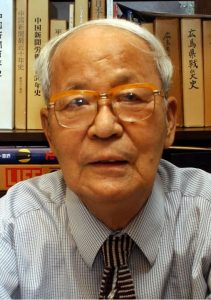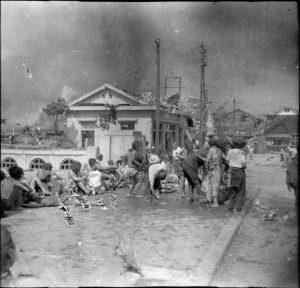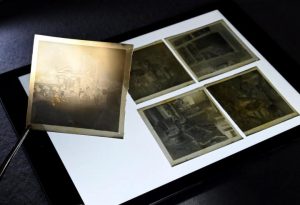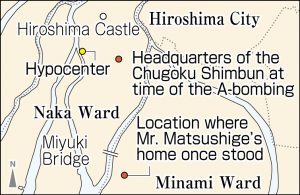Striving to fill voids in Hiroshima, evidence of victims remains 76 years after atomic bombing―Photos of A-bombing destruction, Part 10: Citizens on August 6 captured by Yoshito Matsushige
Dec. 15, 2021
Mission and devastation clashed, leading to photos taken through his tears
Communicating his experience until later years, he passed down memories to future generations
by Kyosuke Mizukawa and Junji Akechi, Staff Writers
A total of more than 2,700 A-bombing photographs of Hiroshima captured by Japanese people in the period after the atomic bombing, from August 6, 1945, until the end of the same year, have been identified. Among that total, only five photos show the tragic circumstances that people faced on August 6, a day of unprecedented chaos. They were taken by Yoshito Matsushige, former staff photographer for the Chugoku Shimbun (who died in 2005 at the age of 92).
At the time of the bombing, Mr. Matsushige was 32 years old. He worked as a photographer for the Chugoku Shimbun and was also a member of the news team at the Chugoku District Military Headquarters, which was located on the grounds of Hiroshima Castle.
Both the Chugoku Shimbun and the military headquarters were located in the center of the city. On the morning of August 6, Mr. Matsushige had just finished his standby duties at the military headquarters in the wake of an air-raid alert and had returned home in what is now part of Nishimidori-machi in Hiroshima’s Minami Ward. “The fact that I happened to be home that morning was the difference between life and death for me,” he said in a video featuring A-bomb testimonies produced by the Hiroshima Peace Culture Foundation in1986.
On his way to work after eating breakfast at home, he suddenly realized he needed to pay a visit to the bathroom and returned back to his home, where he experienced the atomic bombing. He felt a tremendous blast, but the house, located 2.7 kilometers from the hypocenter, did not collapse. He crossed Miyuki Bridge, located near his home, and made an attempt to head for the Chugoku Shimbun or the military headquarters. Witnessing the ferocity of the flames, however, he made his way back to the bridge.
“Taking photos without helping anyone”
Dozens of people with burned hair and skin were moaning and weeping on Miyuki Bridge, where he had retreated. He aimed the camera at them but hesitated to snap the shutter. “They were in such sorry shape. I had a feeling they would think I was just taking photos of them without attempting to help,” he said.
After some hesitation, Mr. Matsushige steeled his heart, took one photo of them from behind, and then moving closer, took another. In personal notes written shortly after the war, he wrote, “I took one photo at first, saying to myself, ‘What a terrible thing they have done!’ When I pressed the shutter for the second shot with feelings of rage and sadness, my tears obscured the view from the viewfinder” (as described in an anthology of photographs titled The First Atomic Bomb Photographic Record of Hiroshima, published in 1952).
In the afternoon, finding that the flames had waned, he entered the city center. He saw bodies piled on top of each other in streetcars. He felt so sorry for the victims he could not bring himself to take any photos in that central area of the city. In addition to the two photos of Miyuki Bridge, he took three other photos, including of the interior of his home, which also served as a barbershop.
He took the five photos after a conflict between his sense of mission as a photographer and the devastation he faced. The photos were widely introduced in Japan and overseas after the end of the occupation of Japan by Allied forces, becoming iconic photos of the atomic bombing. In 1978, Mr. Matsushige, along with other photographers, formed a group called the Association of Photographers of the Atomic Bomb Destruction of Hiroshima, which called for preservation of the photographic negatives of A-bombing images. In 1998, he passed on the rights to the negatives to the Chugoku Shimbun and asked the company to preserve and utilize them.
Passing on other memories besides photos
The negatives were designated as important tangible cultural assets by the Hiroshima City government in March 2021. Hearing the news of the designation, Kayo Inoshita, 78, Mr. Matsushige’s eldest daughter who lives in Miyoshi City in Hiroshima Prefecture, recalled again her father’s commitment to communicating his experience while showing his photos until he had reached his later years. She said, “I will never forget how choked up I was when I heard my father share his account at my daughter’s junior high school.”
In his account, Mr. Matsushige talked in detail about the situation when he took the photos and also about the devastation he was unable to capture. He said in the video that included his testimony, “We must pass on to the next generations the idea that war must never happen again. That is also my mission as a photographer who witnessed what happened on August 6 through his viewfinder.” That is why he talked about his own experience.
He was conflicted about aiming the camera at the wounded and those who were grieving family being taken from them, but thought about the mission of the military and the work of professionals. The experiences and feelings of A-bomb survivors and the bereaved, of whom he took photos while he himself had suffered the devastation of the nuclear weapon, are certainly varied. At the same time, scenes that should never be repeated are recorded in each and every photo.
What was happening inside and outside of the photo frames? What do the photos say, including information not shown in the photos? The newspaper will analyze and convey the photos based on the memoirs, accounts, and memories passed down by families. It is now our obligation to witness the devastation wrought by the atomic bombing through the eyes of photographers who experienced the tragedy.
(Originally published on December 15, 2021)











